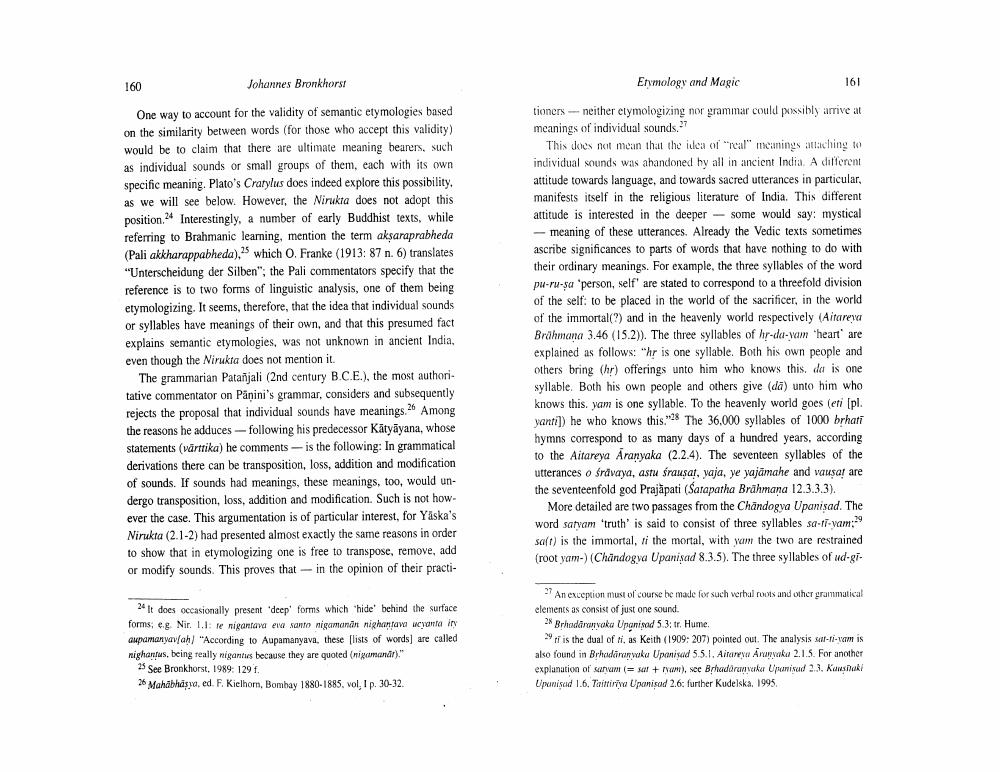Book Title: Etymology And Magic Yaskas Nirukta Flatos Cratylus And Riddle Of Semanticetymologies Author(s): Johannes Bronkhorst Publisher: Johannes Bronkhorst View full book textPage 8
________________ 160 Johannes Bronkhorst Etymology and Magic 161 One way to account for the validity of semantic etymologies based on the similarity between words (for those who accept this validity) would be to claim that there are ultimate meaning bearers, such as individual sounds or small groups of them, each with its own specific meaning, Plato's Cratylus does indeed explore this possibility, as we will see below. However, the Nirukia does not adopt this position. Interestingly, a number of early Buddhist texts, while referring to Brahmanic learning, mention the term aksaraprabheda (Pali akkharappabheda)," which 0. Franke (1913: 87 n. 6) translates "Unterscheidung der Silben", the Pali commentators specify that the reference is to two forms of linguistic analysis, one of them being etymologizing. It seems, therefore, that the idea that individual sounds or syllables have meanings of their own, and that this presumed fact explains semantic etymologies, was not unknown in ancient India, even though the Nirukta does not mention it. The grammarian Patañjali (2nd century B.C.E.), the most authoritative commentator on Panini's grammar, considers and subsequently rejects the proposal that individual sounds have meanings. Among the reasons he adduces-following his predecessor Kätyāyana, whose statements (varttika) he comments is the following: In grammatical derivations there can be transposition, loss, addition and modification of sounds. If sounds had meanings, these meanings, too, would undergo transposition, loss, addition and modification. Such is not how ever the case. This argumentation is of particular interest, for Yaska's Nirukta (2.1-2) had presented almost exactly the same reasons in order to show that in etymologizing one is free to transpose, remove, add or modify sounds. This proves that in the opinion of their practi tioners neither etymologizing nor grammar could possibly arrive at meanings of individual sounds." This does not mean that the idea of "real" meanings attaching to individual sounds was abandoned hy all in ancient India. A different attitude towards language, and towards sacred utterances in particular, manifests itself in the religious literature of India. This different attitude is interested in the deeper - some would say: mystical - meaning of these utterances. Already the Vedic texts sometimes ascribe significances to parts of words that have nothing to do with their ordinary meanings. For example, the three syllables of the word pu-ru-sa person, self' are stated to correspond to a threefold division of the self: to be placed in the world of the sacrificer, in the world of the immortal(?) and in the heavenly world respectively (Altarea Brahmana 3.46 (15.2)). The three syllables of hy-da-yam 'heart' are explained as follows: "hr is one syllable. Both his own people and others bring (hr) offerings unto him who knows this. da is one syllable. Both his own people and others give (da) unto him who knows this, yam is one syllable. To the heavenly world goes (eti (pl. yanti]) he who knows this." The 36.000 syllables of 1000 brhati hymns correspond to as many days of a hundred years, according to the Aitareya Aranyaka (2.2.4). The seventeen syllables of the utterances o fravaya, astu srausat, yaja, ye yajāmahe and vausar are the seventeenfold god Prajapati (Satapatha Brahmana 12.3.3.3). More detailed are two passages from the Chandogva Upanisad. The word satyam "truth' is said to consist of three syllables sa-ti-vam: saft) is the immortal, ti the mortal, with vam the two are restrained (root yam-) (Chandogya Upanisad 8.3.5). The three syllables of d-gi * It does occasionally present 'deep' forms which "hide behind the surface forms; eg Nir. II: re nigantava er santo nigamanan nighantava contain aupamanyavah/ "According to Aupamanyava, these lists of words] are called righantus, being really nigantes because they are quoted (nigmandr)." 25 See Bronkhorst. 1989: 129 f. 26 Mahabhapya, ed. F. Kielhom, Bombay 1880-1885, vol. 1 p. 30-32. 27 An exception must of course he made for such verbalnoots and other grammatical elements as consist of just one sound. 2% Brhadaravaka Upanised 53: tr. Hume. i is the dual of las Keith (1909: 207) pointed out. The analysis sull-ti-am is also found in Brhadirayaka Upanised 55.1. Aire Angaku 2.1.5. For another explanation of unum ( sol + vam), see Brhadarumvuke Upwisud 2.3. kowski Upinised 1.6. Taittiriya Upanisod 2.6: further Kudelska. 1995,Page Navigation
1 ... 6 7 8 9 10 11 12 13 14 15 16 17 18 19 20 21 22 23 24 25 26 27 28 29
